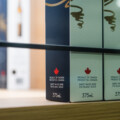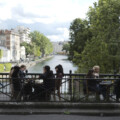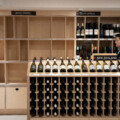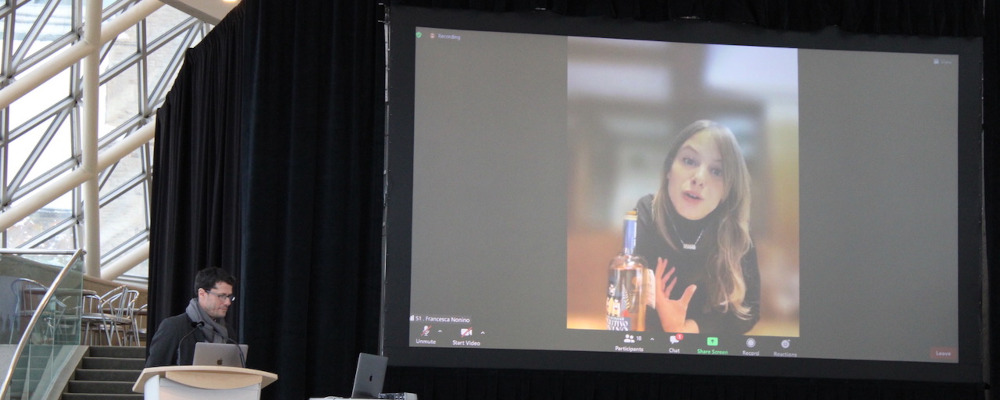Here in Toronto, the wine trade is still inching towards some kind of post-pandemic normalcy. COVID and its effects remain strong enough to keep things weird, but there is discernible progress. Restaurants are pouring glasses of wine again, but many can’t keep open as much as their owners would like because of staff shortages. Agents are importing wine, but can’t always tell when they’ll be delivered because of the shipping crisis. And marketers, like the Italian Trade Agency, are once again holding real-life tastings, but in limited ways to reduce spread.
The version of a wine tasting held by the Italians this week was sit-down and curatorial. About two dozen wine trade and media people were spread out at individual tables with one aperitif and a dozen poured glasses of wine in front of us. The makers of the wine appeared on a large screen at the front of the room, and they Zoomed into the room as we tasted through their wines, led through by a prominent local wine critic.
The tasting was meant to restart the Italian Trade Commission’s annual grand tasting, which was suspended in 2020 because of the lockdowns. That tasting had grown to be one of the biggest in the city, with hundreds of open wines and dozens of producers. The room would be crowded by restaurateurs and the occasional journalist tasting and spitting as much as they could while chatting with their colleagues. The selection of wines for the subdued (though hopeful) 2021 version was chosen from producers that had done well in Canada, either in retail stores or restaurants in the last 25 years or so since the first big tasting in 1994. This is to say the wines were not obscure.
The wines ranged in age from two to five years old and in price from about $15 to $50; the mean and median age of the wines was three years, and $20 to $25 a bottle. Every bottle of wine is its own unique and distinct creation, but it could be reasonably said that the 12 wines could be fairly compared against each other. I go to Italian wine tastings because I like (most) Italian wine, and I found merit in all of them including a Piceno from the Marche, a Montepulciano from Abruzzo, a Barbera d’Asti from Piedmont, and a half dozen wines from Tuscany.
All the wines were good wines. If I preferred one over another, it was usually because of a personal preference or taste rather than for the quality of the winemaking or some kind of mythological problem. In this way, the three last wines I did not love; though I thought they were well made. What they had in common were relatively high levels of residual sugar.
Residual sugar refers to whatever sugar is leftover in a wine once fermentation has stopped. Grape juice turns to wine during fermentation when yeast turns sugars into alcohol. It’s conventional wisdom among oenological historians that in the old days wines tended to be sweeter than they are now. That fact may have had more to do with the lack of control winemakers had over fermentation than consumer taste, per se. Yeast will die in a cold, unheated cellar, leaving more sugar in the wine.
Residual sugar refers to whatever sugar is leftover in a wine once fermentation has stopped.
Once winemakers had temperature-controlled cellars, then temperature-controlled tanks, they could control the lifespan of their yeasts and decide their preferred ratio of sugar to alcohol. The first six wines I tasted all had residual sugar levels of 2 grams per litre, which is about as dry as can be. With minimum sugar levels, these wines showed greater acidity, a quality associated with palate-cleansing, food-friendly wines.
The last three wines had residual sugar levels closer to 10 grams per litre. Physiologically, or nutritionally, that’s not actually a huge difference. It’s roughly the difference between a solution of 0.02 percent sugar to 0.1 percent. By way of comparison, a soft drink might have 80 grams per litre, and a dessert wine might go up to 200. But the difference in winemaking style is enough for the tastebuds on the tongue to discern.
The three wines with relatively higher sugar levels were all from the Valpolicella region of Northeast Italy, near Verona. Two were Amarone, which is made in part with grapes that have been dried for a few months after harvest to concentrate their sugars. The other one was a Ripasso, which is wine into which the pressings from making Amarone are “re-passed” with fresh grapes to be made into wine. Amarone began to be made commercially in the 1960s as a dry version of a dessert wine called Ricioto. Once the winemakers of Valpolicella could control the conditions of their cellars, they could make a dry wine from a sweet one.
I hesitated to name the origins of the last three wines for two reasons. First, they were well made and were in balance. The Corvina grape that dominates the region’s red wine blends is highly acidic and can stand up to sweetness. The regular, or Classico, red wines of Valpolicella are known for their freshness. Second, I spent a week in Verona and Valpolicella tasting all kinds of Amarone and Ripasso, and there are lots of them made to super low sugar levels, often by new generation winemakers. There are modernizers modernizing a modernized wine.
All three of those wines are from relatively large producers whose labels are popular with Canadian consumers. I trust they know what they’re doing and they are meeting consumer demand. The provincial liquor monopolies don’t advertise their top-selling brands, but a quick look-up of one of America’s biggest-selling reds, available across Canada, showed a sugar level of 14 grams per litre.
The reason I could look up all of these wine’s sugar levels is that the Liquor Control Board of Ontario provides that information, as well as alcohol by volume percentages, at the LCBO website and at their shelving displays. The SAQ and BC Liquor do too. With red wine, it’s usually a pretty helpful indicator of the flavour profile of what’s in the bottle. It’s less helpful with white wines because they often have much higher levels of acid to balance the sugar and maintain freshness, but every clue helps in the search for a wine made in the style one likes.
Recommended for You

Malcolm Jolley: The comfort of familiar favourites—or the fun of finding new wines?

Malcolm Jolley: An ‘Elbows Up’ wine project everyone can get behind

Malcolm Jolley: Need some summer wines? Look no further than the food-friendly, low-sugar sippers of the sunny Southern Rhône

Malcolm Jolley: Need a date-night drink? French Northern Rhône wines are worth the investment




